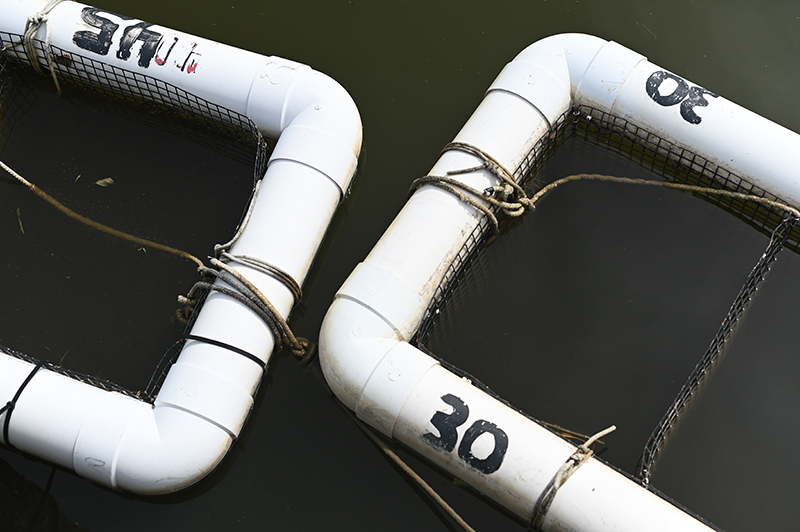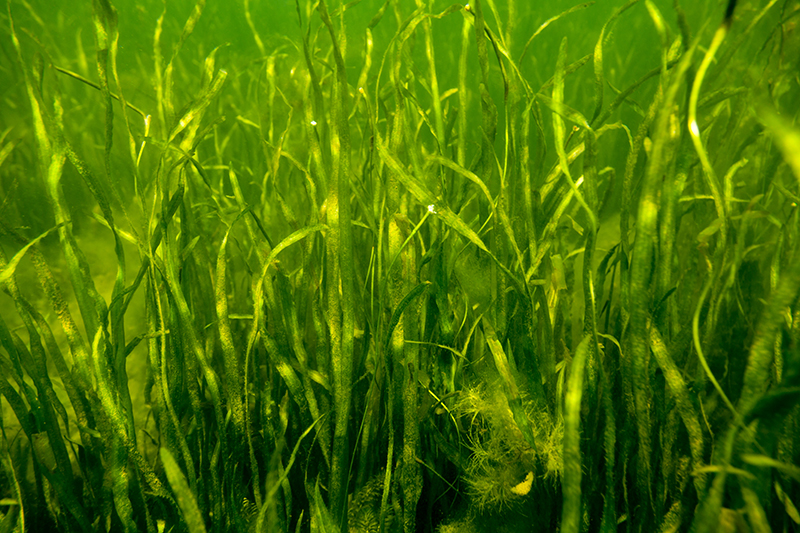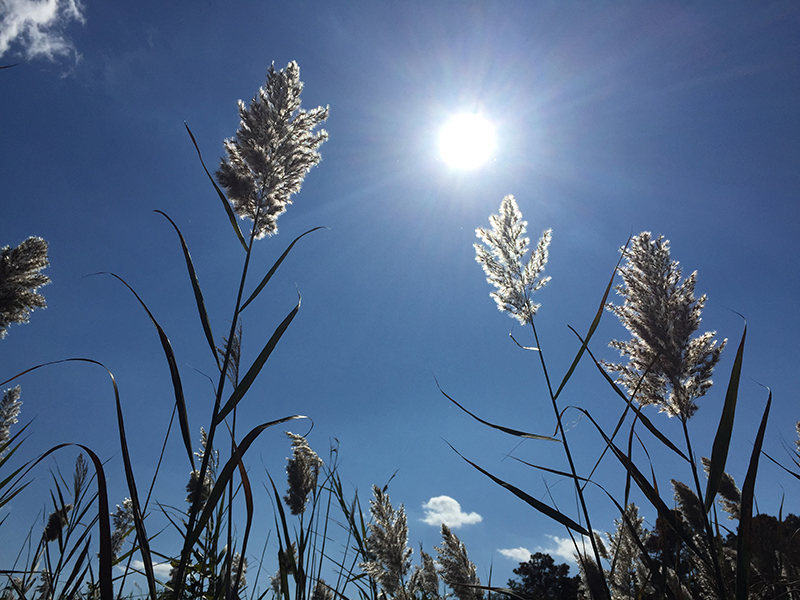Knauss legislative fellowships in Congress help build careers — and they're fun and educational. See our video and fact sheet for details.
Maryland Sea Grant to Fund Research on Ecosystems, Fisheries, and Aquaculture

Maryland Sea Grant has awarded approximately $1 million in federal funding for eight two-year grants to support research on Chesapeake Bay oysters, freshwater salination in urban rivers, harvest policies for Atlantic menhaden, the role of phragmites in ecosystems, and monitoring forage fish such as shad and herring.
About $140,000 in federal funds plus a 50 percent match from non-federal sources will support each project annually. The funds will support not only research but also scientific training for undergraduate and graduate students from Maryland colleges and universities and outreach efforts to Bay stakeholders and communities. The projects were awarded through a competitive, peer-reviewed selection process.
The research will be led by experts from the University of Baltimore, the University of Maryland Center for Environmental Science, the University of Maryland College Park, Smithsonian Environmental Research Center, Morgan State University, and St. Mary's College of Maryland.
The project topics are:
1) Salt in freshwater
Higher levels of water-soluble salts due to use of road salt, water softeners, and increased runoff from hard surfaces affect many watersheds; some Maryland streams already exceed the Environmental Protection Agency’s chloride limit of 250 mg/l. These increased levels of salts can threaten aquatic organisms and habitat and hinder stream restoration efforts. Fluctuations in salinity—typical after de-icers are used on roads during winter storms—can also enhance the transport of nitrogen, phosphorus, and toxic metals from sediments to streams. This study will assess how salts mobilize these nutrients and metals in urban streams, and determine concentrations and fluxes of salts, nutrients, and metals before and after winter storms to better inform the limits that states place on these inputs. The researchers plan to share their information in fact sheets and scientific papers, as well as make the data freely available.
Investigators
Sujay Kaushal and Shuiwang Duan, University of Maryland, College Park

2) Oyster biodeposits
The growing business of shellfish aquaculture in Maryland has largely been viewed as positive for the environment because filter-feeding oysters pull nutrients from surrounding waters. But little is known about the physical and biological properties of the matter—called biodeposits—that oysters expel afterward, largely landing in sediments. When factors like currents and erosion move these biodeposits from aquaculture sites, they may help remove nitrates and nitrogen elsewhere while mitigating the effects of too much nitrogen at the original site. Learning more about how susceptible these biodeposits are to erosion, as well as their long-range transport, is key to understanding the ecological effects of oyster aquaculture. This project will mimic off-bottom aquaculture to study the impact of biodeposit export. This data will be used to create ecosystem models to help develop best management practices for oyster aquaculture.
Investigators
Elka Porter, University of Baltimore; Jeffrey Cornwell and Lawrence Sanford, University of Maryland Center for Environmental Science Horn Point Laboratory
3) Oysters and nutrient reduction
Restored natural oyster bars and oyster aquaculture in Maryland will lead to more of these native bivalves in the Chesapeake Bay and its tributaries. More oysters means better water quality as oysters filter more nutrients. Aquaculturists could receive nutrient credits for investing in restoration, but it’s still unclear how much particular nutrients, like nitrogen, are filtered on natural reefs versus in aquaculture, and where such filtration is most successful. This research will apply a newly developed, fine-scale model system for oyster filtration, biodeposit production and transport, and sediment and reef nitrogen cycling to measure nitrogen reductions in aquaculture and natural reef conditions under various settings. The resulting nitrogen removal estimates will provide data to support how to credit aquaculture best management practices, as well as help identify ideal locations to for oyster aquaculture leases in Maryland.
Investigators
Jeremy Testa and Lora Harris, University of Maryland Center for Environmental Science Chesapeake Biological Laboratory; Lawrence Sanford, University of Maryland Center for Environmental Science Horn Point Laboratory
4) Triploid oysters
Triploid oysters—produced by crossing tetraploid oysters with normal diploid oysters—are important for Maryland aquaculture because they grow quickly and yield more meat. Developing tetraploid stock is crucial to meeting the demand for triploid oysters, but it’s difficult to create lines of these oysters that grow well in low-salinity environments. This project will establish the first generation of tetraploid stock derived from local Maryland oyster populations. Several intermediate lines used to produce the tetraploid will be developed and deployed at three sites to evaluate how well they grow in different areas. This tetraploid stock will enable production of a new triploid seed that will grow quickly and tolerate low-salinity areas. It will also provide a foundation that can be used to develop additional superior lines. Produced and distributed in collaboration with the Maryland Department of Natural Resources Piney Point Aquaculture Center, this will provide new triploid seed to Maryland growers and enhance the sustainability, profitability and resilience of the Maryland aquaculture industry.
Investigators
Ming Liu, Amber DeMarr, and Richard Lacouture, Morgan State University

5) Oysters and grasses
Until recently, Maryland law restricted aquaculture gear in areas where submerged aquatic vegetation (SAV) was known to reoccur in hopes of protecting Bay grasses, which have increased in recent years. But Maryland’s governor approved a law that gives the Department of Natural Resources greater flexibility in placing aquaculture leases where SAV may be present. That provision will end in 2024, giving the state four years to evaluate how oysters and grasses interact. This research will examine regional differences in the probability of conflict between SAV growth and oyster aquaculture, as well as whether existing operations have affected SAV growth and in what ways. The goal is to provide data that will guide Chesapeake Bay restoration and the oyster aquaculture industry.
Investigators
Cassie Gurbisz, St. Mary’s College of Maryland; Jeremy Testa and Dong Liang, University of Maryland Center for Environmental Science Chesapeake Biological Laboratory
6) Herring and shad
The Chesapeake Bay has seen declines in river herring and shad, anadromous alosine fishes that are critically important to ecosystems and the cultures and economies of coastal communities. Researchers have developed new monitoring tools for river herring (alewife and blueback herring) including environmental DNA (eDNA) and sonar image-based run counts. But they need additional eDNA monitoring to establish baseline habitat use for American and hickory shad in Mid-Atlantic rivers. This project will extend eDNA-based monitoring of alosine fishes in Chesapeake Bay to American and hickory shad, test how well high-frequency eDNA sampling accurately estimates river herring abundance, compare flow-corrected eDNA abundance to sonar-based run counts, and use eDNA to examine habitat use of river herring and shads, focusing sampling at fish passage projects. The team will disseminate research results through partnerships with non-profit, conservation, and government agencies.
Investigators
Louis Plough, University of Maryland Center for Environmental Science Horn Point Laboratory; Matthew Ogburn, Smithsonian Environmental Research Center

7) Life after phragmites
Phragmites australis is an invasive plant in Chesapeake Bay wetlands that often outcompetes native plants and thrives in areas where there are increased nutrients and ecosystem disturbances. While Phragmites’ invasive success is well known, what’s not known is what replacement plants best help ecosystems recover, where they should go, and what the negative effects of removing Phragmites might be. This research will use experimental plantings to determine which native species provide the highest potential for restoration and carbon storage in wetlands with different salinities; monitor vegetation where Phragmites was removed years ago to quantify patterns of recovery in wetlands with different salinities; and provide management agencies, institutions, civic organizations, and individuals with guidelines and protocols to effectively restore sites following Phragmites removal.
Investigators
Dennis Whigham and Melissa McCormick, Smithsonian Environmental Research Center; Karin Kettenring, Utah State University; Andrew Baldwin, University of Maryland, College Park
8) Menhaden
Atlantic menhaden (Brevoortia tyrannus) is a migratory fish that plays a vital role in Chesapeake Bay and Mid-Atlantic marine ecosystems as an important food source for striped bass and a coastwide commercial species. The Atlantic States Marine Fisheries Commission, which manages menhaden for the entire coast, is developing an Ecosystem-Based Fisheries Management (EBFM) approach. Stakeholders are especially interested in how this approach will affect striped bass. This research will provide scientific guidance on best practices for setting menhaden harvest policies that meet EBFM’s stock goals. Researchers will evaluate alternative harvest control rules for menhaden using a linked, age-structured, predator-prey simulation model of menhaden and striped bass. The results can provide guidelines for changing quotas in response to stock conditions and fishery performance. This modeling tool will help managers evaluate tradeoffs among fishery objectives such as stability in menhaden and striped bass biomass, risk of overfishing menhaden and striped bass, stability in striped bass fisheries catch, and striped bass health.
Investigators
Genevieve M. Nesslage and Michael Wilberg, University of Maryland Center for Environmental Science Chesapeake Biological Laboratory; Katie Drew, Atlantic States Marine Fisheries Commission; Amy Schueller, National Marine Fisheries Service
Photo, top left: Maryland Sea Grant supports a wide range of research projects in the Chesapeake Bay watershed, focused on the region’s rich ecosystems, the challenges they face, and the industries they support. Photo credit: MDSG / Tossey






